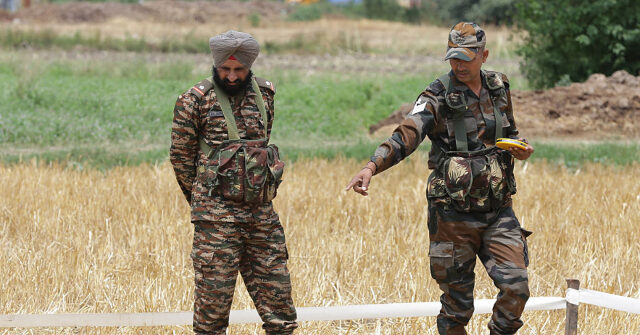The conflict between India and Pakistan continued on Thursday, with each side accusing the other of using drones to attack military targets in a major escalation of hostilities.
Both sides also claimed they were able to neutralize the drone attacks.
The Pakistani military claimed it was able to shoot down 25 of India’s Israeli-made Harop drones overnight. A civilian was reportedly killed, and several soldiers were injured, by debris from the destroyed drones.
The Harop is a long-range drone that can “loiter” over a target site for hours, gathering information or attacking high-value targets by detonating their explosive payloads.
The Indian Armed Forces (IAF) is one of Israel’s major clients for drone technology. The IAF reportedly purchased dozens of Harop drones beginning in 2009, at a cost of around $10 million apiece, so if Pakistan really shot down 25 of them, it would represent a significant depletion of India’s drone capability.
Pakistan said the Indian drones went after military targets, including an air-defense radar system in Lahore. India’s “Operation Sindoor” strikes, launched on Tuesday night in response to a brutal April 22 terrorist attack in Kashmir, carefully refrained from hitting Pakistani military facilities to avoid escalation.
“It appears India has, apparently, lost the plot and rather than going on a path of rationality is further escalating in a highly charged environment to satisfy the hubristic mindset of its government,” Pakistani military spokesman Ahmed Sharif Chaudhry said.
Pakistani Defense Minister Muhammad Asif said India’s drone strikes made a Pakistani military response “increasingly certain.”
“I will still refrain from saying it is 100%. But the situation has become very difficult. We have to respond,” he said.
The IAF confirmed that it struck the air defense radar site in Lahore, in addition to other Pakistani radar facilities. Contrary to the Pakistani statement, the IAF said the Lahore facility was severely damaged or destroyed in the attack.
India said these strikes were necessary because Pakistan “attempted to engage a number of military targets in Northern and Western India” using its own “drones and missiles.”
“These were neutralized by the Integrated Counter UAS Grid and Air Defense systems. The debris of these attacks is now being recovered from a number of locations that prove the Pakistani attacks,” the Indian government said.
“Indian response has been in the same domain with the same intensity as Pakistan. It has been reliably learnt that an air defense system at Lahore has been neutralized,” India said.
The Indian statement said Pakistan has “increased the intensity of its unprovoked firing across the Line of Control (LoC),” the border between Indian and Pakistani territory in Kashmir.
“Sixteen innocent lives have been lost, including three women and five children, due to Pakistani firing. Here too, India was compelled to respond to bring Mortar and Artillery fire from Pakistan to a halt,” the statement said.
Eliminating Pakistani air defense systems would clear the way for India to conduct more air strikes deep into Pakistani territory.
Asif said on Wednesday that President Donald Trump is leading the effort to de-escalate the India-Pakistan conflict, and Islamabad would welcome even more assistance from Washington to “bring down the temperature in the region.”
Secretary of State Marco Rubio spoke with Pakistani Prime Minister Shehbaz Sharif on Thursday morning, stressing the need for de-escalation. Director of National Intelligence Tulsi Gabbard has reportedly been in contact with Indian defense officials.
Indian media quoted intelligence sources who said Rubio contacting Sharif directly was intended as a rebuke to Pakistani Foreign Minister Isaq Dar, who has described the terrorists who perpetrated the April 22 massacre as “freedom fighters.”
Asif suggested Pakistan is willing to halt military action if India takes no further steps to attack, and he claimed Pakistan has been much less aggressive about shooting down manned Indian aircraft than it could have been.
“We could have taken down ten planes yesterday. We had the opportunity, but we restricted it to five planes and two UAVs (unmanned aerial vehicles) because we didn’t want to expand this situation,” he said on Wednesday, referring to Tuesday night’s Indian airstrikes.
India initially denied that it lost any planes on Tuesday, but on Wednesday local government sources in Kashmir said three of India’s fighters crashed at different locations in the disputed territory.
Read the full article here


